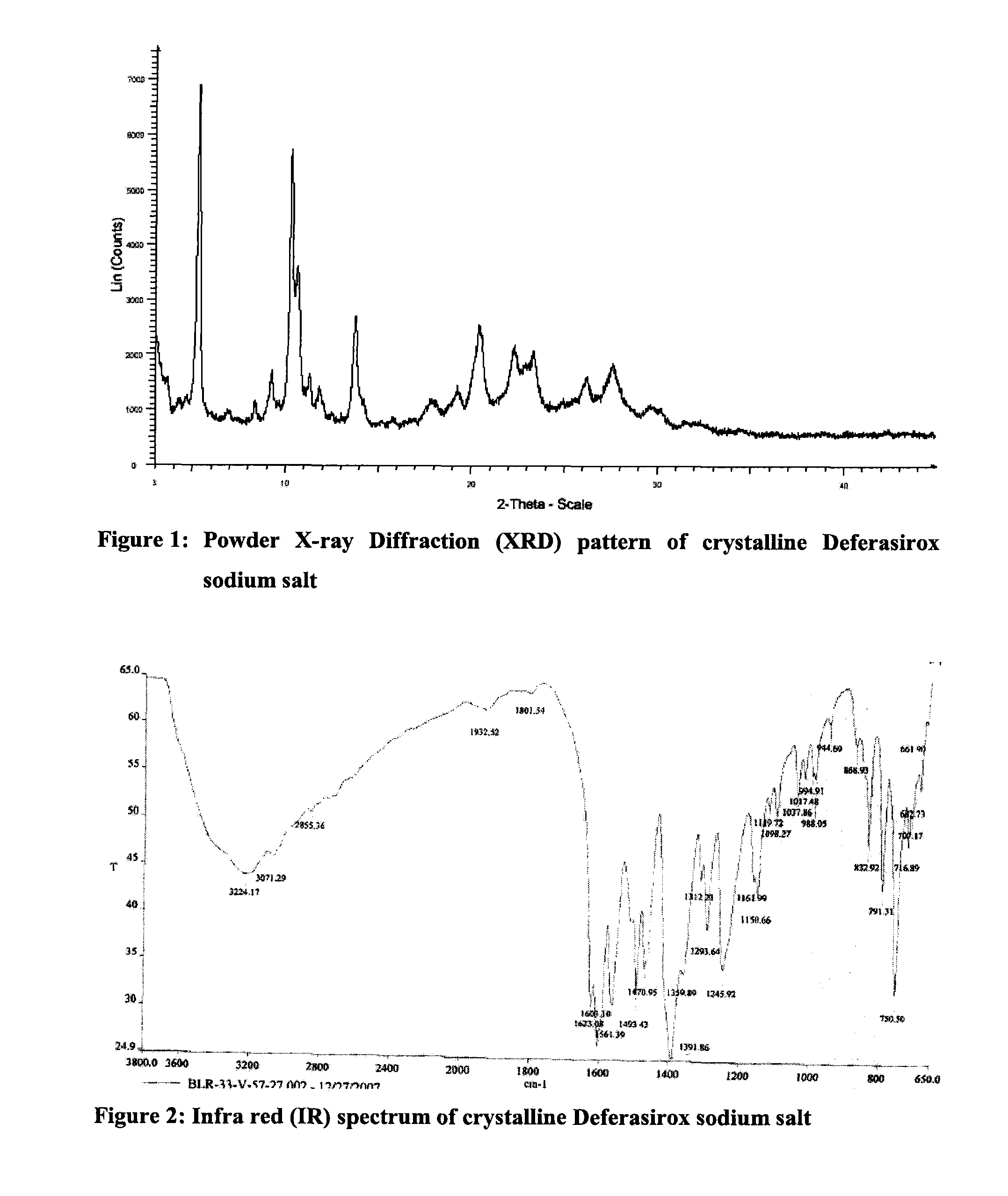Solid state forms of deferasirox salts and process for the preparation thereof
a deferasirox salt and solid state technology, applied in the direction of aerosol delivery, antinoxious agents, metabolism disorders, etc., can solve the problems of experimental details not provided for this synthetic route, and achieve the effects of enhanced temperature, good flow properties, and high purity
- Summary
- Abstract
- Description
- Claims
- Application Information
AI Technical Summary
Benefits of technology
Problems solved by technology
Method used
Image
Examples
example 1
Preparation of 2-(2-Hydroxyphenyl)-4H-1,3-benzoxazine-4-one
[0220]Salicylic acid (50 gm) was taken in xylene (250 ml) followed by the addition of thionyl chloride (64.5 gm) drop wise to the reaction mixture at 25-30° C. The reaction mixture was stirred for 90 minutes at 40-45° C. The excess thionyl chloride was removed by distillation. Salicylamide (49.7 gm) was added to the resulting mixture and followed by the distillation of xylene up to a reaction temperature of 170° C. The reaction mixture was further stirred for 60 minutes at 80° C. followed by the addition of ethanol (80 ml) and refluxed for 15 minutes. The resulting mass was cooled to 25° C. and stirred for 30 minutes at the same temperature. The resulting solid was filtered and dried to produce 43 gm of 2-(2-hydroxyphenyl)-4H-1,3-benzoxazine-4-one as slightly yellow crystals. (Melting point: 206-208° C.).
example 2
Preparation of 2-(2-Hydroxyphenyl)-4H-1,3-benzoxazine-4-one
[0221]Salicylic acid (50 gm) was taken in toluene (125 ml) followed by the addition of thionyl chloride (64.5 gm) drop wise to the reaction mixture at 20-30° C. The reaction mixture was stirred for 90 minutes at 40-45° C. The resulting mass was distilled under vacuum until to remove about 100 ml of toluene along with the excess thionyl chloride. Salicylamide (49.7 gm) was added to the resulting mixture and followed by the distillation of the toluene up to a reaction temperature of 170° C. The reaction mixture was further stirred for 60 minutes at 165-170° C. followed by the addition of methanol (150 ml) at 60° C. and refluxed for 15 minutes. The resulting mass was cooled to 25° C. and stirred for 30 minutes at the same temperature. The resulting solid was filtered and dried to produce 43 gm of 2-(2-hydroxyphenyl)-4H-1,3-benzoxazine-4-one as slightly yellow crystals. (Melding point: 206-208° C.).
example 3
Preparation of 4-[3,5-Bis(2-hydroxyphenyl)-1H-1,2,4-triazol-1-yl]benzoic acid (Deferasirox)
[0222]2-(2-Hydroxyphenyl)-4H-1,3-benzoxazine-4-one (25 gm, 0.1045 moles) and 4-hydrazinobenzoic acid (17.5 gm, 0.115 moles) were taken in ethanol (375 ml). The reaction mass was heated to reflux and refluxed for 2 hours. The resulting mass was cooled to 25° C., the resulting solid was filtered and dried to produce 30.4 gm of 4-[3,5-Bis(2-hydroxyphenyl)-1H-1,2,4-triazol-1-yl]benzoic acid (Melting point: 264° C.).
PUM
| Property | Measurement | Unit |
|---|---|---|
| temperature | aaaaa | aaaaa |
| temperature | aaaaa | aaaaa |
| molar ratio | aaaaa | aaaaa |
Abstract
Description
Claims
Application Information
 Login to View More
Login to View More - R&D
- Intellectual Property
- Life Sciences
- Materials
- Tech Scout
- Unparalleled Data Quality
- Higher Quality Content
- 60% Fewer Hallucinations
Browse by: Latest US Patents, China's latest patents, Technical Efficacy Thesaurus, Application Domain, Technology Topic, Popular Technical Reports.
© 2025 PatSnap. All rights reserved.Legal|Privacy policy|Modern Slavery Act Transparency Statement|Sitemap|About US| Contact US: help@patsnap.com



